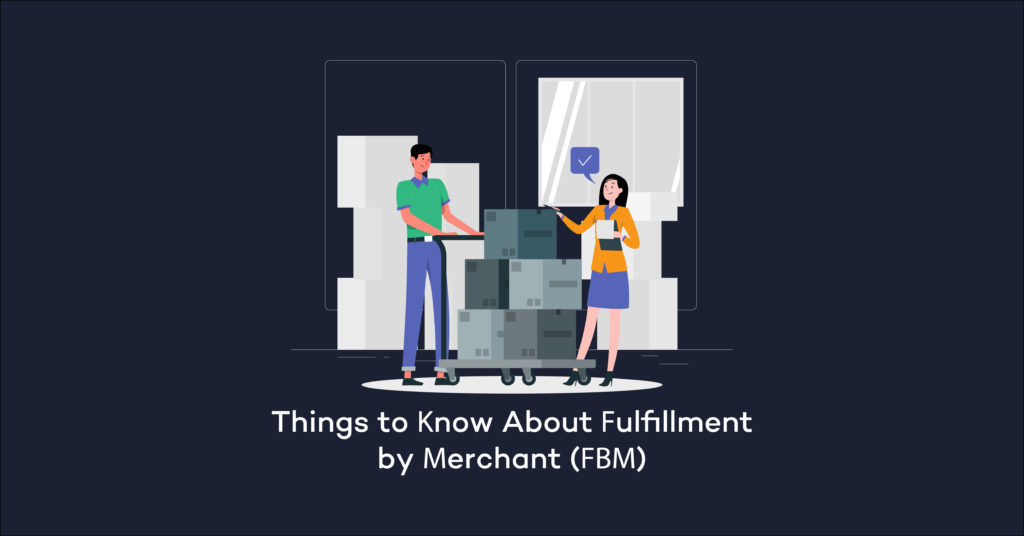AI Amazon Repricer
Boost your Amazon profits and avoid price wars with AI repricing
Amazon is a well-known eCommerce platform that gained popularity not only for its extensive customer base but also due to its convenient fulfillment choices.

Amazon is a well-known eCommerce platform that gained popularity not only for its extensive customer base but also due to its convenient fulfillment choices. Beyond utilizing Amazon FBA, sellers and online entrepreneurs can opt for Amazon FBM or MFN.
This article aims to give you an overview of Amazon FBM and provide key insights into Amazon’s Merchant Fulfilled Network.
FBM, which stands for Fulfilled by Merchant, is one of the fulfillment options provided by Amazon. Although many online sellers use the term FBM, some also use the alternative term MFN, or Merchant Fulfilled Network, to describe the same fulfillment process.
Whether referred to as FBM or MFN, both terms essentially describe the same selling method where online sellers list their products and handle storage, shipping, and customer support independently.
Simply put, addressing the question “what is FBM” essentially represents sellers managing crucial elements of the Amazon business, primarily overseeing storage, shipping, and Amazon customer service.
Sellers with Individual or Professional plans can choose Amazon FBM as their fulfillment option. It gives Amazon sellers more flexibility in addressing specific fulfillment needs and obtains a competitive edge.
Sellers with Individual plans can specify their shipping rates via Amazon Seller Central. If you operate in multiple regions or Amazon marketplaces, you can set the shipping rate accordingly to charge Amazon shoppers appropriately. Below is a walkthrough guide courtesy of Amazon Seller University to help you configure your shipping rate.
For sellers on the Professional selling plan who are able to choose FBM as an alternative fulfillment method, they can likewise set their own shipping rates. You can customize shipping templates for specific Amazon marketplace, allowing you to define shipping charges by order, per item, and/or per weight.
It is worth noting that the referral fee likewise applies to sellers who choose the FBM method while on the professional selling plan. You can check Amazon’s Standard Selling Fees to learn more about referral fees.
If you’re considering selling on Amazon and are contemplating whether to use Amazon MFN or FBM as your fulfillment method, here’s a brief overview of the essential steps to initiate your FBM journey on Amazon.
To start using FBM on Amazon, you will need to create an Amazon seller account first. When signing up for a seller account, Amazon suggests to prepare the following:
Once you have created an Amazon seller account, you can now start listing your products via Amazon Seller Central. There are two ways in which you can start listing products on Amazon. You can either create a new listing from scratch or use existing listings.
Amazon suggests finding product detail pages that match your product to save time. You can use the following to search terms or product identifiers when searching the Amazon product catalog to check existing listings.
Enhancing inventory management will increase the profitability of your Amazon business while using the FBM method. Maintain inventory levels that meet customer demand, avoiding overstocking or out-of-stock situations.
Since you will be handling the storage of your products, be sure to monitor inventory levels consistently. Anticipate increased product demands, particularly during peak periods like seasonal holidays or major sales events such as Amazon Black Friday, Amazon Cyber Monday, or Amazon Prime Day.
Utilize the Amazon Seller Central dashboard to select shipping templates within the Manage Inventory section. It’s essential to configure your Default Handling Time and Order Handling Capacity to safeguard your business from unforeseen spikes in orders.
Since you will be handling the order fulfillment, be sure to oversee the fulfillment process and check for potential issues along the way. Ensure that you efficiently manage the product selection, packing, and delivery of orders to customers. Additionally, make sure to confirm that the carriers you employ are either included in Amazon’s approved network of tracking-rate carriers or are authorized carriers.
A vital order processing element entails choosing suitable packaging: boxes, paper or bubble mailers, and packaging materials like bubble wrap or air fillers. Adhering to all Amazon packing and preparation requirements is crucial to cutting costs and preventing item damage during transportation.
Ensuring successful campaigns on Amazon relies heavily on providing efficient customer service. How you handle customer inquiries or feedback is crucial in ensuring customer satisfaction. It is advisable to promptly address customer messages or feedback, ideally within 24 hours. A survey indicates that nearly 50% of customers anticipate a response in less than 4 hours.
Maintaining a proactive approach to customer service can increase the chances of converting occasional online shoppers into loyal Amazon customers. Regularly monitor customer service metrics in Amazon Seller Central to stay updated on feedback and responses.
Expenses can vary depending on several factors. Important factors influencing your expenses as an Amazon FBM seller include your selling plan, referral, shipping costs or fees, and even third-party service fees.
Like Amazon FBA, Fulfillment by Merchant or Amazon MFN likewise has pros and cons. Here are some advantages and disadvantages to give you an idea of what to expect when using FBM.
Fulfillment Process Control: The most evident advantage of using FBM as your Amazon fulfillment method is having complete control over the entire fulfillment process. FBM allows you to decide on the critical aspects of the business, including packaging materials, and oversee quality control and shipping methods.
Cost-Effective: Amazon FBM fees are known to be more favorable for sellers. If you already have your own shipping infrastructure or storage facility, using FBM can be more cost-effective. In such a case, Amazon FBM sellers can avoid fulfillment fees associated with FBA.
Flexibility: Amazon FBM offers sellers the flexibility to make some changes to their inventory and shipping processes instantly, including packaging and inventory levels.
Faster Response to Changes: Sellers can quickly adapt to changes in product availability, pricing, or promotions since they have direct control over their inventory.
Improved Profit Margin (Selected Products): Since FBM provides lower fulfillment costs, sellers can expect a better profit margin for certain products, especially for those low-profit margin items that are bulky or heavy to transport.
Limited Prime Eligibility: Products shipped under FBM are not eligible for Prime, which may affect your sales as many Amazon shoppers prefer Prime-eligible products for their benefits, such as faster shipping.
Reduced Visibility: FBM sellers may need help making their products more visible on Amazon’s organic search result page, as the Amazon algorithm favors FBA products.
Workforce Challenges: Amazon sellers lacking a substantial workforce may encounter difficulties in effectively managing the complete fulfillment process and addressing customer service needs. This challenge becomes more evident when handling significant order volumes, Amazon return requests, and multiple customer inquiries. Consequently, the scalability of Amazon’s business is constrained for sellers operating with limited or no staff.
Limited International Reach: Although Fulfillment by Merchant (FBM) offers convenience to Amazon sellers operating on a local marketplace, extending its use to the global marketplace can be demanding. When employing the FBM method in the international market, sellers will have to manage shipping logistics and comply with customs requirements, potentially restricting their market reach.
Amazon offers sellers various fulfillment alternatives tailored to their business objectives and requirements. Assessing your priorities and business requirements is essential when deciding between Amazon FBM and Amazon FBA.
Typically, smaller Amazon businesses may find the FBM method more advantageous. Additionally, selecting the FBM approach could be a better match for certain products, offering a practical choice for your Amazon venture.

Set up in minutes with the help of our customer success team, or reach out to our sales team for any questions. Start your 15-day free trial—no credit card needed!
